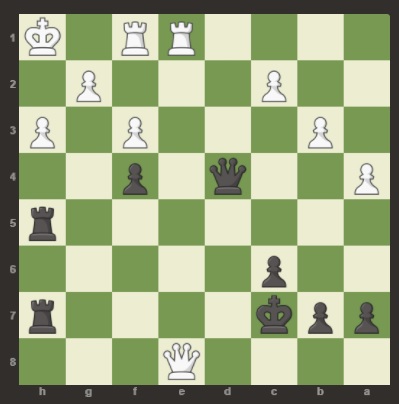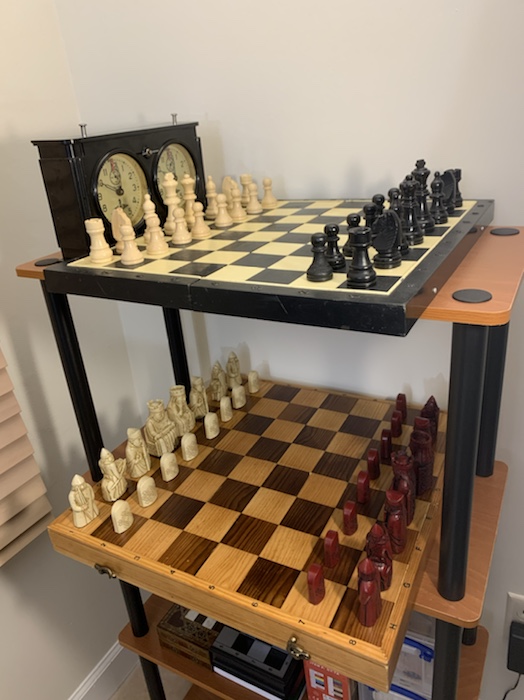
Please remember me when shopping online. Thanks in advance. US HERE – UK HERE
Priestly chess players, drop me a line. HERE
Black to move.

Fifty years ago in Reykjavík, the controversy raged behind the scenes about the venue, the Laugardalshöll arena. Fischer was claiming that the noise from spectators in the area was turning the match into a farce and started demanding that he and Spassky play in a closed room. Meanwhile, the Icelandic Chess Federation had already taken rows of seats out, banned the sale of anything wrapped in cellophane and denied entry to children under 10, which surely upset a lot of people. Game 16 is on the horizon tomorrow, 20 August 1972.
Spassky will, himself, apply some psyops.
Meanwhile, in our own day in Reykjavík, it was announced that the FIDE Fischer Random World Championship will start with qualifiers on 22 August (which is the anniversary of the Battle of Bosworth Field before which you can bet some of the participants played chess, but before the powerful Queen developed). I can hear some of you wags into the chessy thing muttering, “A horse! A horse!…”. Which leads me to imagine that someone out there has at some point made a Richard III v. Henry Tudor or at least a War of the Roses set.
“Fischer Random” (aka “Chess960”, because there seem to be 960 setups possible) is a variant game which rearranges the pieces on the 1st and 8th ranks such that it is still possible to castle and there are bishops of opposite colors. Fischer wanted a kind of pure game which didn’t involve memorization of openings and lines. Other than the setup, the regular rules of chess are followed.
Today, software will instantly calculate and place the pieces. However, in the absence of computer engines – remember this for the time of the zombie apocalypse when the dems announce lockdown for COVID-960 and they turn of the internet – there is a formula that can be used… which I don’t understand. It can involve either coin tosses, the use of a standard die or polyhedral dice, or shuffling cards or scrabble letters. Strange stuff. For example, in 2018 in a Fischer Random Blitz tournament – and I’m struggling to get my head around that, Carlson and Nakamura both were able to castle on their first moves, having their kings and rooks on f1/g1 and f8/g8. In other words, on both sides the kings and rooks were next to each other, so they swapped squares, putting their kings in the corners. Recorded games have to, of course, include the opening position with a PGN or FEN.
Fischer announced his variant after his second match with Spassky in 1992. And in 1993 Fischer went to Hungary to consult (read: “hide out”) with the legendary chess Polgár family, László Polgár and his chess playing daughters Judit, Zsuzsa and Zsófia. Judit had broken Fischer’s record for becoming the youngest grandmaster. Zsófia wound up beating Fischer at his own game several times. László showed Fischer a book from the early 20th century which already had proposed something similar, which prompted Fischer to change the rules to his version.
Some people think that Chess960 is the future of chess, because it lends itself to greater pure creativity without the book openings and theory. To quote USA supergrandmaster Wesley So (today playing in the Winners Bracket in the Rapid Chess Championship):
“My favorite form of chess is actually chess960. Because there’s not much theory, not much preparation, it’s very original. With the traditional format, the engines are just getting super strong, and it feels like you have to memorize the first 20-25 moves just to get a game. Bobby Fischer once said that the problem with chess is that you get the same exact starting position over and over. These days, there’s 10 million games in the database already, so it’s very hard to create original play, while chess960 is really your brain against mine. After the first or second move, you’re already thinking.”
Here’s an example of what chess960 looks like from a game between Wesley So and veteran Garry Kasparov.
“There is nothing wrong with your screen. Do not attempt to adjust the setup. We are now controlling the position. We control the horizontal and the vertical. We can deluge you with a thousand positions or expand one single move to crystal clarity and beyond. We can shape your vision to anything our imagination can conceive.”
And to think that I struggle to play normal chess with non-Staunton pieces!
(PS: Deep thanks to a reader here who sent me replicas of the Lewis chessmen. They are at present on the board I refurbished some time ago. As a matter of fact, there was once a game arranged between Nigel Short and Judit Polgár using the 12th c. Lewis chessmen but the British Museum backed out even though they were assured that chess is not a contacts sport. Not usually, at least.)



































I love chess 960! The only problem with it is it is much harder to find someone else to play as well.
I have my own set of dice for selecting a random starting position: one black four sided die, one white four sided die, one five sided die, one six sided die, and one last four sided die.
To setup the board, first one rolls the black and white four sided dice. The light and dark squared bishop go on the respective colored square that number of square from the left on the back rank. Next comes a six and then a five sided die roll. This successively places a knight on one of the remaining empty back rank squares; again the die number corresponds to the “nth” empty square from the left on the back rank. Finally, the last four sided die places the queen. That leaves three remaining empty back rank squares, and by the rules of chess 960, the king must go in the middle empty square with the rooks occupying the other two.
Also Fr. Z, in chess 960 castling the king and rook always end up on the same squares as they would after castling in traditional chess. So players could not “put their kings in the corner” as you mentioned.
See here for all the gory details: https://www.mark-weeks.com/c960/mw14f28.htm
Sorry for all the repeat posts, but here is an interesting video of Magnus Carlsen losing a chess960 game on move 7 by apparently forgetting about the castling rules: https://www.youtube.com/watch?v=Kfx6l2SKfyU